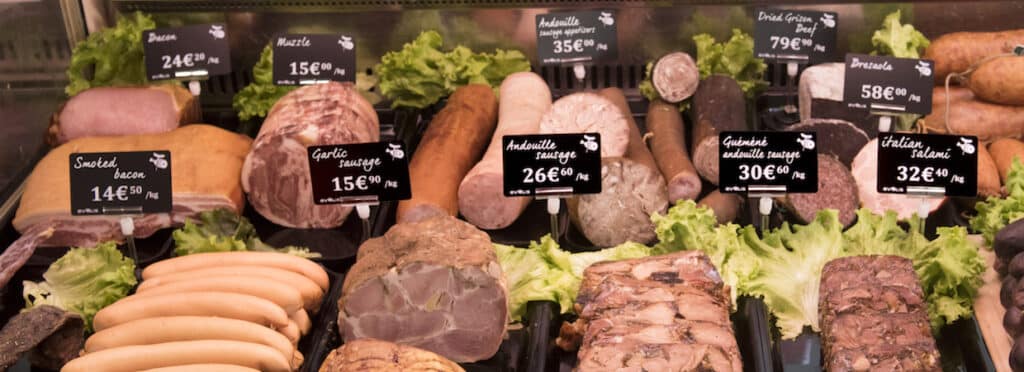Introduction
Even if a product’s packaging is well designed and attractive, it’s no use if customers don’t pay attention to it. And with so many attractive items in the same shop, how can you ensure that certain items stand out from the rest?
One of the best ways to do this is to harness the power of effective product presentation, combined with an attractive sales floor. By using carefully chosen tricks and techniques, you can optimise the way shoppers navigate your shelves and view certain items in your shop, while asserting your shop’s brand and overall image. In this article, we explain exactly how to achieve this.
What makes an effective display?
Use visual merchandising to highlight the advantages of certain products
Strategic visual merchandising and an attractive sales area motivate customers to make specific purchasing decisions.
Visual merchandising is an excellent way of making an immediate impact on customers. The customer journey begins with discovery, using elements such as price cards and price card holders allows you to start a conversation with potential buyers, encouraging them to take a closer look at your products and make certain purchasing decisions.
When used effectively, these marketing aids can also create a unique and attractive atmosphere in your shop, playing with the possibilities, from colours and patterns to layout and materials, to create a positive, brand-focused sales area that’s much more likely to convert.
Use your visual brand image to create your shop's unique atmosphere and vision of the world
Visual merchandising is just one more tool in your arsenal to create a powerful experience for shoppers. And at the end of the day, that’s what people are really looking for in their shopping experience, whether they’re buying online or in-store.
However, having a physical shop allows you to play with a number of different elements to create a totally unique and captivating environment, reflecting your brand’s vision and worldview. As well as tried and tested product display strategies, your POS and price cards can be used to differentiate you from your competitors and create a unique and exciting selling surface that entices shoppers to pick up one of your products.
How can you incorporate price cards into your displays?

Use uniform spacing for easy-to-read product presentations
Price cards and displays are most effective when product names, prices and high-quality images are evenly distributed throughout the display layout.
Coherence plays an important role in the way we process information. Without going into the scientific details, when information is ordered and spaced consistently, it is much easier for people to process, making them more likely to respond positively to any message about the product.
To ensure your success, apply uniform spacing and layout models on all your screens. This means using the same line spacing between sentences and equal spacing between the different visual elements of your cards, such as images or symbols.
All this allows you to introduce some much-needed ‘breathing space’ into your marketing messages, making them easier (and more enjoyable) to digest. Above all, it helps to create a more visually appealing atmosphere that can affirm your brand.
Use price card sizes that perfectly match your products
Choosing the right size of price card or other visual aid is extremely important. Something that’s too big or too small won’t have the desired effect. The trick is to balance the size and shape of your price cards with each type of product. For medium-sized products, a small price card should suffice. While a larger price card may attract attention, it actually obscures the view of the actual product.
You should also ask yourself whether it is better to place the price card in front of or behind the product to get the best effect. Use your common sense to find the ideal position, but pay attention to the angle from which customers approach the product.
Finally, even if you use a collection of different price cards and POS materials, try to create unity throughout your shop’s visual merchandising by using complementary models, sizes and layouts.
The 3 main product presentation techniques that boost sales

Place your most valuable products along the "golden line
The ‘golden line’ is the most convenient height for the average buyer to reach out and pick up the product. This is around 85 to 150 cm from the ground. If you don’t remember anything else from this blog (and we know you won’t!), remember that most products sold in a shop are taken from this golden line.
Whether this is because shop owners and managers already adhere to this technique and always place their best items on it, or whether it’s simply a psychological effect, is up to you to decide, but whatever the case, it’s important to place your products strategically on your shop shelves with this in mind.
However, the ease with which a person can reach out and pick up an object at a certain height depends of course on their specific height. If you want to be really strategic, take into account the size of your average customers, which can vary according to gender or nationality.
Place your most highly recommended products in the centre or slightly to the right
Following the same “convenience principle”, place your recommended items in the centre of your shelves or slightly to the right.. It turns out that this is where people naturally focus their attention. What’s more, it’s the easiest place to reach (90 % of people are right-handed).
As a result, in Placing your important products there will increase their visibility and the likelihood of your customers placing these items in their shopping basket.
Arrange your most and least saleable items interchangeably
For some popular products, customers are likely to seek them out and buy them, wherever they are placed. However, other items are overlooked by everyone. To even the odds, place your most and least saleable items on the same shelves or surfaces to increase the chances that your hardest-to-sell items will be selected.
An excellent example of this strategy is to place products that sell easily at either end of your shelves, while dedicating the central part to less desirable products that you would like to sell off quickly. These items will borrow some of the credibility of their more popular counterparts and customers may unconsciously re-evaluate their buying decision on this basis.
If you want to test this theory, why not try placing one of your most ‘difficult’ products next to your best-selling products and see what happens?
